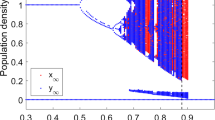Abstract
A simple one-dimensional model of single-species populations is studied by means of computer simulations. Although the model has a rich spectrum of dynamics including chaotic behavior, the introduction of survival thresholds makes the chaotic region so small that it can be hardly observed. Stochastic fluctuations further reduce the chaotic region because they accidentally lead populations to extinction. The model thus naturally explains the observation that the majority of natural populations do not show chaotic behavior but a monotonic return to a stable equilibrium point following a disturbance.
Similar content being viewed by others
Literature
Berryman, A. A. and J. A. Millstein. 1989. Are ecological systems chaotic—and if not, why not?Trends Ecol. Evol.,4, 26–28.
Conway, E. D. and J. A. Smoller. 1986. Global analysis of a system of predator-prey equations.SIAM J. appl. Math.,46, 630–642.
Crutchfield, J. P., J. D. Farmer and B. A. Huberman. 1982. Fluctuations and simple chaotic dynamics.Phys. Rep.,92, 45–82.
Feigenbaum, M. J. 1978. Quantitative universality for a class of nonlinear transformations.J. stat. Phys. 19, 25–52.
Hassell, M. P. 1975. Density dependence in single-species populations.J. Anim. Ecol.,44, 283–295.
Hassell, M. P., J. H. Lawton and R. M. May. 1976. Patterns of dynamical behaviour in single-species populations.J. Anim. Ecol. 45, 471–486.
Iwasa, Y. and H. Mochizuki. 1988. Probability of population extinction accompanying a temporary decrease of population size.Res. pop. Ecol.,30, 145–164.
Lorenz, E. N. 1963. Deterministic nonperiodic flow.J. atmos. Sci.,20, 130–141.
May, R. M. 1974. Biological populations with non-overlapping generations: stable points, stable cycles, and chaos.Science 186, 645–647.
May, R. M. and G. F. Oster. 1976. Bifurcations and dynamic complexity in simple ecological models.Am. Nat. 110, 573–599.
Morris, W. F. 1990. Problems in detecting chaotic behavior in natural populations by fitting simple discrete models.Ecology 71, 1849–1862.
Nisbet, R. M. and W. S. C. Gurney. 1982.Modeling Fluctuating Populations. New York, U.S.A.: Wiley.
Nisbet, R., S. Blythe, B. Gurney, H. Metz, K. Stokes, A. Lomnicki and G. S. Mani. 1989. Avoiding chaos.Trends Ecol. Evol.,4, 238–240.
Odum, H. T. and W. C. Allee. 1954. A note on the stable point of populations showing both interspecific cooperation and disoperation.Ecology 35, 95–97.
Pimm, S. L. and A. Redfearn. 1988. The variability of population densities.Nature 334, 613–614.
Rössler, O. E., 1976. An equation for continuous chaos.Phys. Lett. 57A, 397–398.
Schaffer, W. M. and M. Kot. 1985. Nearly one dimensional dynamics in an epidemic.J. theor. Biol. 112, 403–427.
Schaffer, W. M. and M. Kot. 1986. Differential systems in ecology and epidemiology. InChaos, A. V. Holden (Ed.), pp. 158–178. Manchester, U.K.: Manchester University Press.
Schuster, H. G. 1988.Deterministic Chaos: An Introduction, 2nd revised edn. Weinheim, Germany: VCH.
Strebel, D. E. 1985. Environmental fluctuations and extinction—single species.Theors. Pop. Biol. 27, 1–26.
Sugihara, G. and R. M. May. 1990. Nonlinear forecasting as a way of distinguishing chaos from measurement error in time series.Nature 344, 734–741.
Turchin, P., P. L. Lorio, Jr., A. D. Taylor and R. F. Billings. 1991. Why do populations of southern pine beetles (Coleoptera: Scolytidae) fluctuate?Environ. Entom. 20, 401–409.
Wilson, E. O. and W. H. Bossert. 1971.A Primer of Population Biology. Massachusetts, U.S.A.: Sinauer.
Author information
Authors and Affiliations
Rights and permissions
About this article
Cite this article
Masutani, K. Effects of survival thresholds upon one-dimensional dynamics of single-species populations. Bltn Mathcal Biology 55, 1–13 (1993). https://doi.org/10.1007/BF02460292
Received:
Revised:
Issue Date:
DOI: https://doi.org/10.1007/BF02460292



